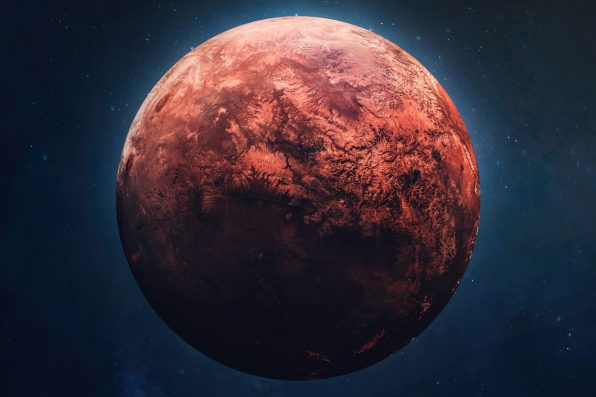A Long-Lost Moon May Be The Reason Why Mars Has Such A Strange Shape And Extreme Terrain

Mars stands out from all the other planets in our solar system because it is the only planet that is an ellipsoid, meaning it has different sizes along all three of its axes.
But how did Mars end up with this unique feature? It could have something to do with a long-lost moon.
Today, Mars has two small moons, but it may have had another, larger moon earlier in its history. The larger moon could be responsible for the planet’s strange shape and terrain, according to Michael Efroimsky, an astronomer from the U.S. Naval Observatory in Washington, D.C.
The terrain on Mars is some of the most extreme in the solar system. It boasts the tallest mountain, the biggest canyon, and the greatest highland region.
The highland region is known as the Tharsis bulge/rise. It is located in Mars’ western hemisphere near the equator.
The Tharsis bulge is around 3,100 miles wide and 4.4 miles high. Its massive shield volcanoes stretch even taller.
On the opposite side of the Red Planet, another highland region and massive shield volcano, Terra Sabaea and Syrtis Major, sit across from Tharsis.
Nerio, the hypothetical moon named after the ancient Roman war goddess, may have altered the shape of Mars with its gravity. It created tides in the magma oceans, similar to how Earth’s moon raises tides in our oceans.
But since Mars is smaller than Earth, it cooled more quickly, and its tidal waves became stuck in the formation they are today.

dimazel – stock.adobe.com – illustrative purposes only
Eventually, Nerio was lost somehow. It may have been eradicated by a collision, leaving behind Phobos and Deimos, Mars’ current moons. Or, a gravitational interaction with another celestial body pushed it out of the solar system.
These types of events were common in the early solar system. Astronomers believe Earth’s moon came from a collision with a protoplanet the size of Mars. Scattered bodies among the outer planets then shifted their initial orbits into their current positions.
Nerio would have continued to deform Mars’ landscape as the planet cooled. After the moon disappeared, further geological processes did the rest of the work.
Efroimsky noted that the Nerio explanation was just a theory, as there is no solid evidence to prove its former existence.
If Nerio did exist and was destroyed, it should have left a series of craters along the belt that aligned with its orbit.
However, no craters of this kind exist, but it is possible that other collisions and geologic activity eliminated all traces of the craters.
It is also not a guarantee that the heating and cooling processes in Mars’ interior would’ve naturally caused distortions in the planet’s shape. Researchers are now working on ways to look for evidence of the lost moon.
The paper can be found as a preprint on the site arXiv.
Sign up for Chip Chick’s newsletter and get stories like this delivered to your inbox.
More About:News